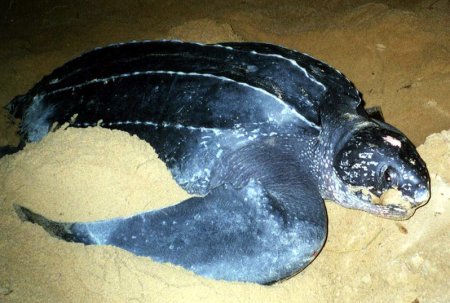|
GreenPlaces
|
|
Wildlife and conservation news from around the U.K. |
|
Menu
|
 |
|
||||||
|
Leatherback turtles (Dermochelys coriacea) are traditionally considered a tropical species that occasionally strayed into UK waters, but new research has found something completely different. The remarkable results, from a collation of Leatherback sightings around the British Isles, encouraged the Irish Sea Leatherback Turtle project to look closer at the movements of these gentle giants, which can weigh up to 880 kilos and measure up to 2.5 metres long. This initial research found that there have been more than a thousand sightings over about 100 years, and it is thought that this figure is probably a huge under-representation of the real numbers of Leatherbacks that visited UK waters. The research also found a distinct pattern to the timings of the sightings, with the highest frequency of sightings occurring between June and October; the time of year when jellyfish are most abundant in British waters. Leatherback turtles feed on jellyfish and other soft sea animals and plants and they have a special 'notch' in their beak to help puncture jellyfish.
The marine biologists working on the project have satellite tracked ten Leatherback turtles that nested in the Caribbean. Nine out of the ten sets of tracking equipment returned data for more than a year. The tracks of two turtles that left the Caribbean in 2002 showed that they traveled east, towards the west coast of Africa. Results from seven turtles that left the Caribbean in 2003 showed that they dispersed more widely, but they all headed in a generally northerly direction. Two traveled north-west to within a few hundred kilometers of Cape Cod and Nova Scotia, while the other five went north-east, to the waters between the Azores and UK. In October, as the northerly waters cooled, they all turned south to look for warmer waters. Dr Houghton, one of the marine biologists who established the Irish Sea Leatherback project said, "It's quite bizarre, it's like finding rhinos in Snowdonia." Previously Leatherbacks in UK waters were thought to have gone astray, but it seems they are a regular part of the British fauna. The scientists working on the Irish Sea Leatherback project concluded that Leatherbacks which finish breeding early in the season head for northern seas to feed on the large numbers of jellyfish present in these cooler waters. When the waters begin to cool in autumn, they head south to spend the winter in warmer waters. Numbers of all turtle species have declined dramatically, worldwide. Reasons for this decline include pollution, fishing, egg collection and coastal development. Long-line fishing is thought to kill approximately 50,000 Leatherback turtles a year when they become accidentally caught on hooks. Research into their behaviour, lifestyle and movements around the world's seas will help the formulation of protection plans for these amazing animals. |
|
|
Links |
|
|
Irish Sea Leatherback Turtle Project |
|
|
World Turtle Trust |
|
|
SeaTurtle.org |
|
|
Matthew Godfrey at seaturtle.org |
|
|
Images |
|
|
Leatherback Turtle (Dermochelys coriacea)., Matthew Godfrey - seaturtle.org |
|

 Over the past couple of years, since it was found that Leatherbacks are extremely common in UK waters, marine biologists from the University of Wales and University College Cork in Ireland have been working on the Irish Sea Leatherback Project. The project is funded by the National Environmental Research Council and the EU and aims to find out about the movements of the turtles and how they manage to survive almost entirely on jellyfish, which are composed of mainly water.
Over the past couple of years, since it was found that Leatherbacks are extremely common in UK waters, marine biologists from the University of Wales and University College Cork in Ireland have been working on the Irish Sea Leatherback Project. The project is funded by the National Environmental Research Council and the EU and aims to find out about the movements of the turtles and how they manage to survive almost entirely on jellyfish, which are composed of mainly water.